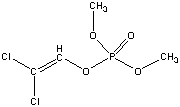
NTP Study Reports

NTP Study Reports
Home » Study Results & Research Projects » NTP Study Reports » All Long-Term Reports » Abstract for TR-342 - Dichlorvos

| Chemical Formula: C4H7Cl2PO4 | - | 3D Structure* |
|---|---|---|
| *To view structure, download free Chemscape Chime Plug-in | ||
Toxicology and carcinogenesis studies of dichlorvos (99% pure), a contact and stomach poison for control of insects and parasites, were conducted by administering dichlorvos in corn oil by gavage to groups of F344/N rats and B6C3F1 mice of each sex for 13 weeks or 2 years. Previous feed studies were done by the National Cancer Institute using Osborne-Mendel rats and B6C3F1 mice.
Thirteen-week studies with groups of 10 rats of each sex were conducted at doses of 0, 2, 4, 8, 16, 32, or 64 mg/kg dichlorvos in corn oil. All rats that received 32 or 64 mg/kg dichlorvos and 4/10 females that received 16 mg/kg died before the end of the studies. Final mean body weights of dosed and vehicle control rats were similar. Thirteen-week studies with groups of 10 mice of each sex were conducted at doses of 0, 5, 10, 20, 40, 80, or 160 mg/kg. All 10 male mice and 9/10 female mice that received 160 mg/kg and 5/10 male mice that received 80 mg/kg dichlorvos died before the end of the studies. Final mean body weights of dosed and vehicle control mice were similar. No compound-related gross or microscopic pathologic effects were observed in rats or mice.
Two-year studies of dichlorvos were conducted by administering 0, 4, or 8 mg/kg dichlorvos, 5 days per week for 103 weeks, to groups of 50 F344/N rats of each sex. Groups of 50 male B6C3F1 mice were administered 0, 10, or 20 mg/kg dichlorvos on the same schedule, and groups of 50 B6C3F1 female mice were administered 0, 20, or 40 mg/kg dichlorvos.
Mean body weights of dosed and vehicle control rats and mice were similar. No significant differences in survival were observed between any groups of rats or mice of either sex (rats--male: vehicle control, 31/50; low dose, 25/50; high dose, 24/50; female: 31/50; 26/50; 26/50; mice-- male: 35/50; 27/50; 29/50; female: 26/50; 29/50; 34/50).
Adenomas of the exocrine pancreas occurred at greater incidences in dosed rats than in vehicle controls (male: vehicle control, 25/50; low dose, 30/49; high dose, 33/50; female: 2/50; 3/47; 6/50). Mononuclear cell leukemia in both dosed groups of male rats occurred more frequently than in vehicle controls (11/50; 20/50; 21/50). Mammary gland fibroadenomas and fibroadenomas or adenomas (combined) in dosed female rats occurred at increased incidences relative to the vehicle controls (9/50; 19/50; 17/50). Multiple fibroadenomas occurred in dosed female rats but not in vehicle controls (0/50; 6/50; 3/50); carcinomas occurred in two vehicle control and two low dose female rats.
In mice, incidences of squamous cell papillomas of the forestomach were increased in the high dose groups compared with those in the vehicle controls (male: 1/50; 1/50; 5/50; female: 5/49; 6/49; 18/50). Two high dose female mice developed forestomach squamous cell carcinomas.
Dichlorvos was mutagenic in Salmonella typhimurium strain TA100 with and without metabolic activation but was not mutagenic in strain TA98. Dichlorvos was mutagenic in the mouse lymphoma L5178Y/TK+/- assay without metabolic activation. Dichlorvos induced sister chromatid exchanges and chromosomal aberrations in Chinese hamster ovary cells in the absence and presence of metabolic activation.
Under the conditions of these 2-year gavage studies, there was some evidence of carcinogenic activity of dichlorvos for male F344/N rats, as shown by increased incidences of adenomas of the exocrine pancreas and mononuclear cell leukemia. There was equivocal evidence of carcinogenic activity of dichlorvos for female F344/N rats, as shown by increased incidences of adenomas of the exocrine pancreas and mammary gland fibroadenomas. There was some evidence of carcinogenic activity of dichlorvos for male B6C3F1 mice, as shown by increased incidences of forestomach squamous cell papillomas. There was clear evidence of carcinogenic activity of dichlorvos for female B6C3F1 mice, as shown by increased incidences of forestomach squamous cell papillomas.
Synonyms: 2,2-dichloroethenyl dimethyl phosphate; 2,2-dichlorovinyl dimethyl phosphate; O,O-dimethyl-O-(2,2-dichlorovinyl)phosphate; DDVP
Trade Names: BAY-19149; DDVF; ENT-20738; OMS-14; SD 1750; Canogard®.; Crossman's Fly-Cake®.; Dedevap®.; De-Pester Insect Strip®.; Estrosol®.; Herkol®.; Kill-fly Resin Strip®.; Lethalaire®.; Mafu®.; Misect®.; Nogos®.; Nuvan®.; No-Pest Strip®.; Oko®.; Phoracide®.; Phosvit®.; Vapona®.; Vaponicide®.; Vaporette Bar®.
Anthelmintics: Atgard®.; Dichlorman®.; Equigard®.; Task®.
Note: Dichlorvos (technical grade) was previously tested in Osborne-Mendel rats and B6C3F1 mice administered in feed (See TR-10, reported 1979).
Report Date: September 1989
Pathology Tables, Survival and Growth Curves from NTP 2-year Studies
Target Organs & Incidences from 2-year Studies
You may link to the full technical report in pdf format ( Note: A print ready copy of the document is presented in Portable Document Format (pdf) which requires the Acrobat Reader plug-in -- download a free copy of the reader.)
Web page last updated on October 14, 2004
The National Institute of Environmental Health Sciences is one of the National Institutes of Health within the U.S. Department of Health and Human Services. The National Toxicology Program is headquartered on the NIEHS campus in Research Triangle Park, NC.